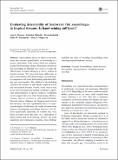Evaluating detectability of freshwater fish assemblages in tropical streams : is hand-seining sufficient?
Abstract
Unprecedented threats to natural ecosystems mean that accurate quantification of biodiversity is a priority, particularly in the tropics which are underrepresented in monitoring schemes. Data from a freshwater fish assemblage in Trinidad were used to evaluate the effectiveness of hand-seining as a survey method in tropical streams. We uncovered large differences in species detectability when hand-seining was used alone, in comparison with when hand-seining and electrofishing were used together. The addition of electrofishing increased the number of individuals caught threefold, and increased the biomass fivefold. Some species were never detected using hand-seining, resulting in significant underestimates of species richness; rarefaction curves suggest that even when hand-seining effort increases, species richness is still underestimated. Diversity indices (Shannon and Simpson index) reveal that diversity was also significantly lower for hand-seined samples. Furthermore, the results of multivariate analyses investigating assemblage structure also differed significantly depending on whether they were based on hand-seined data alone, or a combination of hand-seining and electrofishing. Despite the extra equipment and maintenance required, these findings underline the value of including electrofishing when sampling tropical freshwater streams.
Citation
Deacon , A , Mahabir , R , Inderlall , D , Ramnarine , I W & Magurran , A E 2017 , ' Evaluating detectability of freshwater fish assemblages in tropical streams : is hand-seining sufficient? ' , Environmental Biology of Fishes , vol. 100 , no. 7 , pp. 839-849 . https://doi.org/10.1007/s10641-017-0610-5
Publication
Environmental Biology of Fishes
Status
Peer reviewed
ISSN
0378-1909Type
Journal article
Description
This work was funded by a European Research Council grant (BIOTIME 250189). AEM also acknowledges the Royal Society.Collections
Items in the St Andrews Research Repository are protected by copyright, with all rights reserved, unless otherwise indicated.

